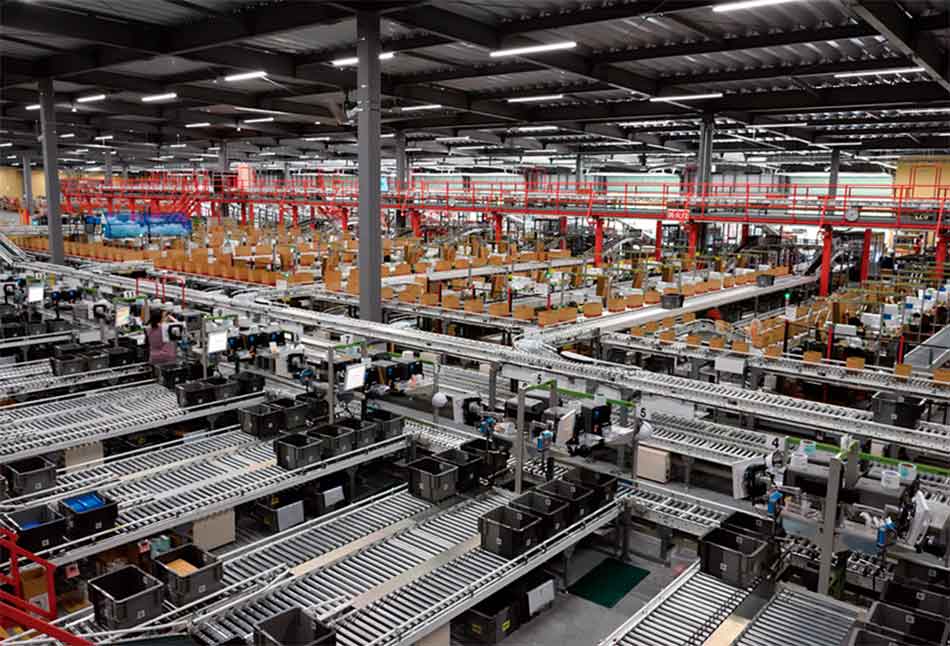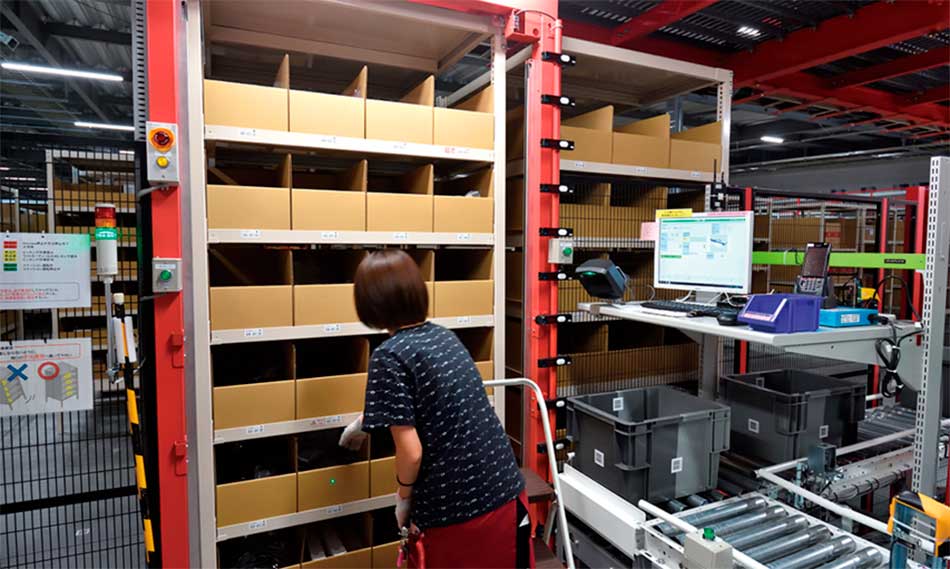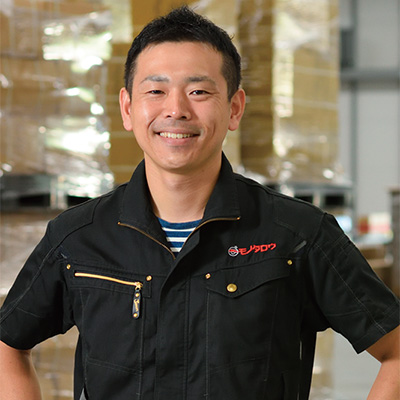COVER STORY:ACTIVITIES2
Construction of a Distribution Center Designed for Automation and Labor-saving Operations
MonotaRO Co., Ltd. has maintained a remarkable rate of growth as a pioneer of the direct marketing of indirect goods. The company built its new Kasama Distribution Center with the aim of improving customer service. We talk to two people involved in constructing the distribution system at the heart of the project.
 Naohiko Gommori
Naohiko Gommori
General Manager, Business Development Division, Business Incubation and Development Division, Social Innovation Business Division, Hitachi, Ltd.
The logistics industry has been facing major challenges in recent years. Behind these lie some dramatic changes in the nature of the industry.
“One of these is a severe labor shortage being experienced in logistics. Another is the rapid expansion of electronic commerce (e-commerce). The logistics industry is finding itself subject to severe demands. Along with the rising demand for delivering what people want, when they want it, this also includes the expectation of being able to dispatch large volumes of products in a short timeframe. This trend is evident not just in consumer sales but also in the business-to-business (B2B) market.”
So says Naohiko Gommori (General Manager, Business Development Division, Business Incubation and Development Division, Social Innovation Business Division, Hitachi, Ltd.) who led an initiative on a logistics service that is transforming the value chain as part of Hitachi’s Social Innovation Business. While logistics services are being called on to operate faster than ever before, countervailing factors such as the impact of labor shortages are becoming more severe. This is creating an urgent need for innovation in the sector to overcome these problems. Given this situation, Hitachi is working on enhancements to logistics services that draw on the latest technologies, including robotics, the Internet of Things (IoT), and artificial intelligence (AI). The collaborative creation project associated with the new Kasama Distribution Center (DC) built by MonotaRO Co., Ltd. provides a good example of this work (see Figure 1).
Figure 1Kasama Distribution Center A single-level building constructed on a large site of more than 90,000 m2, the distribution center entered full operation in May 2017.
A single-level building constructed on a large site of more than 90,000 m2, the distribution center entered full operation in May 2017.
MonotaRO, a company that has achieved ongoing growth since setting up a website for B2B sales in 2000, deals mainly in “indirect goods,” meaning goods that are not used directly in the production of other products. These are goods used in factories and other workplaces and include parts such as screws and bolts, tools such as drills and hammers, gloves, packaging, and so on. Because the number of these products is so large, the purchasing departments of companies and other organizations have found that purchasing what they need causes efficiency problems. It was MonotaRO that brought about a transformation in these inefficient procurement networks.
MonotaRO’s strength lies both in its range of 13 million products and in its development of a website with advanced search capabilities that make it easy for users to find what they want. It achieves a high rate of repeat sales through the use of data marketing (the analysis of the search and purchase histories of website users), including offering recommendations to users and customizing the content of the e-mail magazines sent to them. The company’s greatest strength of all, however, is undoubtedly that it has pursued a distribution strategy that aims for same-day dispatch to ensure service convenience for customers. As a result, the number of registered users in Japan has reached more than 2.5 million.
Distribution centers are essential if a diverse variety of products are to be delivered to customers as quickly as possible. MonotaRO commissioned its Amagasaki DC (in Hyogo Prefecture) in April 2014 to serve as its main distribution center. It has a capability of dispatching 30,000 shipments per day. Once the Amagasaki DC was up and running, the company then went on to plan the construction of a new center in eastern Japan to further boost its warehousing capacity.
Figure 2Interior of the Kasama DC

 The photographs show the product consolidation and inspection area (top) and dispatch area (bottom). The center features a variety of measures aimed at rationalizing the flow of goods, including constructing it on a single level to eliminate vertical movements.
The photographs show the product consolidation and inspection area (top) and dispatch area (bottom). The center features a variety of measures aimed at rationalizing the flow of goods, including constructing it on a single level to eliminate vertical movements.
The new DC covering eastern Japan was built in Kasama City in Ibaraki Prefecture. In addition to being well-placed for taking delivery of products and dispatching them to customers, with good access to highways and other transportation, business continuity planning (BCP) was another consideration in choosing the site thanks to its geological stability making it resilient to disasters. Nevertheless, the most important consideration of all in site selection was the ability to secure a vast area of land. As well as providing scope for expanding warehousing capacity, this was due to the plans MonotaRO had for new initiatives that would make operations even more efficient through techniques such as reorganizing the movement of goods. Hitachi participated in the construction of the Kasama DC from the early stages, targeting a dispatch capability double that of the Amagasaki DC.
Mr. Gommori explains, “Having undertaken requirements definition and other engineering work based on factors such as the quantities handled by the Amagasaki DC and its rate of growth, we went on to handle the full range of tasks from proposing the system configuration to actual system implementation. Moreover, the entire Hitachi Group got involved in the project. Hitachi Architects & Engineers Co., Ltd. handled construction planning and work management at the center in ways that took account of the materials handling equipment layout, and Hitachi Systems, Ltd. installed the center’s local area network (LAN).”
The project introduced radical innovations in distribution in order to achieve its productivity target. The first of these innovations was to reorganize the movement of goods to eliminate vertical movements. The high cost of land leads to many Japanese distribution centers being built on multiple levels. In contrast, the Kasama DC project involved constructing a distribution center covering approximately 56,192 m2 on a large site of approximately 90,400 m2, twice the area of the Tokyo Dome. The reason such a large facility was built on a single level was to achieve efficient operations by eliminating the vertical movement of goods (see Figure 2).
The second innovation was to design the facility for automation and labor-saving operations. A key consideration in this was that, of all the processes from delivery of inward goods to order dispatch, picking was the one with the greatest scope for improvement. The Amagasaki DC has a picking cart system that uses tablet computers. By providing pickers with the location, name, quantity, and photograph of the product, this method of picking products from shelves is efficient and accurate while also ensuring that pickers follow the shortest route. However, because this method requires pickers to spend more than half of their daily shifts walking about, the idea was conceived to improve productivity by reducing this walking time.
 Koji Moritsuna
Koji Moritsuna
Manager, Logistics Systems Department, Machinery Systems Division, Industrial Products Business Unit, Hitachi, Ltd.
The key to automation and labor-saving operations is Hitachi’s Racrew automated guided vehicle. Racrew is a robot that operates according to data instructions, traveling autonomously to a designated shelf and then lifting it up and carrying it. In the picking process at the Kasama DC, these robots improve efficiency by bringing the shelves containing products to the workers, reducing their workloads (see Figure 3). Even without using an automated guided vehicle like this, it would still be possible to have pallets or buckets carried to the pickers by instead adopting an automated warehouse (materials handling equipment). However, the two methods are very different. Koji Moritsuna (Manager, Logistics Systems Department, Machinery Systems Division, Industrial Products Business Unit, Hitachi, Ltd.) who worked on the design of the equipment at the Kasama DC, explains as follows.
“What distinguishes Racrew is that it is a distributed system. As we are using 154 Racrew robots to improve the efficiency of operations at the Kasama DC, if one Racrew fails, its work can be taken over by another. An automated warehouse, in contrast, uses fixed equipment, such that if a crane breaks down, it takes a certain amount of time to restore it to operation. Along with this issue of the operational continuity of the distribution system, another major feature of Racrew is the system’s excellent expandability and flexibility, such as the ease with which it can cope with changes in the size of shelf gaps or increases in the volume of stock.”
Figure 3Racrew Automated Guided Vehicles As of October 2017, the center operated 154 Racrew robots in areas used to hold products in moderate demand. The movement of the robots is under the control of a warehouse control system (WCS).
As of October 2017, the center operated 154 Racrew robots in areas used to hold products in moderate demand. The movement of the robots is under the control of a warehouse control system (WCS).
e-commerce companies have a particular need for responsive distribution. They have a much wider product range than a brick-and-mortar store and frequently need to deal with spikes in orders for particular products, such as when they are featured in the media. If MonotaRO decides that it needs to boost the capabilities of its distribution center in order to keep up with this fluctuating demand, it can do so by increasing the number of Racrew robots.
Mr. Moritsuna adds, “Nevertheless, this was the first time we had ever supplied more than 150 Racrew robots to a single distribution center. Although the robots follow optimal routes that avoid getting in each other’s way, using the conventional controller-based method for controlling the movement of 154 of them at once would have been complicated by factors such as the hardware capacity constraints of the computer. Instead, the area traversed by the Racrew robots was split up into blocks, each of which was controlled separately using multiple controllers. However, because there was still a need for robots to travel between blocks, we adopted a system that included interoperation between controllers.”
Before commissioning the actual system, they borrowed a large warehouse and conducted repeated simulations based on assumptions including changes in dispatch volume, number of items, and growth rate, etc. These simulations were used to carefully check operations, including how many robots can operate in a given layout.
Figure 4Picking Efficiency Improvement

 The picking stations (top) are located outside the area in which the Racrew robots operate(bottom). Workers are able to process goods without needing to walk any great distance. Further improvements in operational efficiency are being considered that use the IoT, AI, and other technologies.
The picking stations (top) are located outside the area in which the Racrew robots operate(bottom). Workers are able to process goods without needing to walk any great distance. Further improvements in operational efficiency are being considered that use the IoT, AI, and other technologies.
Deliveries to the Kasama DC began in March 2017, with full operation commencing in May. The Racrew robots travel vertically and laterally between the storage locations and the picking stations, passing under product shelves located over a region 135 m wide and 200 m long. Thanks to the significant efficiency improvements this brought to picking operations, the productivity targets for the project were achieved (see Figure 4). That the 154 Racrew robots travel a distance of 1,300 km each day gives a good indication of how much “walking time” has been reduced.
Hitachi has plans for further collaborative creation with MonotaRO in the future, having already started on proposals for upgrading the Kasama DC. One of these proposals takes advantage of the ability of the Racrew to interoperate with the IoT.
Mr. Gommori explains, “We are investigating how to improve overall transportation efficiency by analyzing operational data collected and archived via the IoT to formulate and implement plans for placing shelves that contain products with a high dispatch frequency in an optimal location. One example would be to use the Racrew to reposition product shelves to optimal locations overnight prior to the day of dispatch. It might also be possible to find ways to boost efficiency further, such as by installing digital solutions to select optimal locations based on factors such as the productivity of individual workers. We are also developing techniques for predicting and detecting faults in materials handling equipment that use AI for the operational management of equipment.”
Based on its experience of collaborative creation with MonotaRO, Hitachi intends to market more widely its advanced services for distribution centers in which Racrew plays a central role, targeting distribution centers for the growing e-commerce sector as well as other large centers. Hitachi is also preparing standard model templates for the installation of Racrew at small and medium-sized distribution centers, and working to establish practices for facilitating installation that use combinations of these templates.
There is no doubt that, as well as being a response to ever worsening labor shortages, these advanced services that use robots and other technology are also playing their part in confronting social issues. With companies taking steps to reform their workplace practices, these issues include doing away with long working hours and achieving a good work-life balance. Hitachi intends to continue pursuing innovations in logistics, not only through its advanced services for distribution centers, but also through those for optimizing the supply chain from beginning to end.
 Hiroki Nishio
Hiroki Nishio
Distribution Center Director, Kasama Distribution Center, MonotaRO Co., Ltd.
MonotaRO’s Kasama DC, which commenced full operation in May 2017, currently has the capacity to handle 20,000 orders per day. The aim is to increase this to 350,000 stock items and 40,000 orders per day in the future. Hiroki Nishio, who now manages the DC, had responsibility for the project to construct what became MonotaRO’s second flagship DC.
He comments, “Our motto is to make our customers aware of the convenience of our services. It goes without saying that the time taken to supply deliveries from the center is foremost among these. Moreover, fulfilling our delivery commitments is a major factor in our customers’ reliance on our company. Accordingly, it was with the aim of improving convenience and ensuring reliability by expanding our capacity for warehousing and dispatch that we constructed our new Kasama DC.
“By adopting Hitachi’s Racrew automated guided vehicles for the first time, we significantly boosted picking efficiency, achieving roughly three times the productivity of past picking operations. The use of automation to reduce workloads and the number of workers has all but eliminated walking by pickers as Racrew robots now bring goods to them based on customer orders. The reduction in human error is another major benefit.
“The Kasama DC project involved considerable effort, including as it did the simultaneous installation of large-scale mechanical systems, among them conveyors and high-speed consolidation buffers for handling picked items as well as the Racrew robots. However, thanks to the backup provided by Hitachi, we got the center up and running smoothly without any major problems. As we have plans to further increase our dispatch capabilities, we look forward to utilizing Hitachi’s engineering capabilities again in the future.”